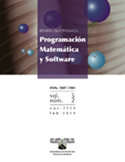Herramienta en MATLAB para acomodo de cajas en 3L-CVRP
DOI:
https://doi.org/10.30973/progmat/2020.12.2/2Palabras clave:
Visualización 3D en 3LCVRP, herramienta 3LCVRPl, logística, programa en MATLABResumen
El problema de enrutamiento de vehículos con carga tridimensional, o 3L-CVRP, es un problema NP-Completo en el campo de la logística. En el 3L-CVRP se consideran las dimensiones de largo, ancho y alto de los artículos y el vehículo. Por lo tanto, cada artículo debe cargarse secuencialmente para evitar que artículos de diferentes clientes se apilen entrelazados, artículos frágiles no deben dar soporte a artículos no frágiles. Los artículos pueden rotarse en los ejes x-y. En este trabajo, se propone un programa MATLAB para trazar las soluciones obtenidas para 3L-CVRP como una técnica para verificar errores tales como superposiciones, intersecciones, área de soporte insuficiente y la combinación no válida de elementos
Citas
P. Toth, D. Vigo, and P. Toth, Vehicle Routing: Problems, Methods, and Applications, Second Edition. 2014.
B. Golden, S. Raghavan, and E. Wasil, “The vehicle routing problem: Latest advances and new challenges,” Oper. Res. Comput. Sci. Interfaces Ser., 2008. https://doi.org/10.1007/978-0-387-77778-8
H. Pollaris, K. Braekers, A. Caris, G. K. Janssens, and S. Limbourg, “Vehicle routing problems with loading constraints: state-of-the-art and future directions,” OR Spectr., 2015. https://doi.org/10.1007/s00291-014-0386-3
M. Gendreau, M. Iori, G. Laporte, and S. Martello, “A Tabu Search Algorithm for a Routing and Container Loading Problem,” Transp. Sci., 2006. https://doi.org/10.1287/trsc.1050.0145
H. Ma, W. Zhu, and S. Xu, “Research on the algorithm for 3L-CVRP with considering the utilization rate of vehicles,” in Intelligent computing and information science, Springer, 2011, pp. 621–629. https://doi.org/10.1007/978-3-642-18129-0_94
G. Fuellerer, K. F. Doerner, R. F. Hartl, and M. Iori, “Metaheuristics for vehicle routing problems with three-dimensional loading constraints,” Eur. J. Oper. Res., 2010. https://doi.org/10.1016/j.ejor.2009.03.046
C. D. Tarantilis, E. E. Zachariadis, and C. T. Kiranoudis, “A hybrid metaheuristic algorithm for the integrated vehicle routing and three-dimensional containerloading problem,” IEEE Trans. Intell. Transp. Syst., 2009. https://doi.org/10.1109/TITS.2009.2020187
L. Wei, Z. Zhang, and A. Lim, “An adaptive variable neighborhood search for a heterogeneous fleet vehicle routing problem with three-dimensional loading constraints,” IEEE Comput. Intell. Mag., 2014. https://doi.org/10.1109/MCI.2014.2350933
L. Junqueira, J. F. Oliveira, M. A. Carravilla, and R. Morabito, “An optimization model for the vehicle routing problem with practical three-dimensional loading constraints,” Int. Trans. Oper. Res., 2013. https://doi.org/10.1111/j.1475-3995.2012.00872.x
T. G. Crainic, G. Perboli, and R. Tadei, “Extreme point-based heuristics for threedimensional bin packing,” INFORMS J. Comput., 2008. https://doi.org/10.1287/ijoc.1070.0250
A. Bortfeldt, “A hybrid algorithm for the capacitated vehicle routing problem with three-dimensional loading constraints,” Comput. Oper. Res., 2012. A hybrid algorithm for the capacitated vehicle routing problem with three-dimensional loading constraints
P. Lacomme, H. Toussaint, and C. Duhamel, “A GRASP×ELS for the vehicle routing problem with basic threedimensional loading constraints,” Eng. Appl. Artif. Intell., 2013. https://doi.org/10.1016/j.engappai.2013.03.012
M. Iori, “An annotated bibliography of combined routing and loading problems,” Yugosl. J. Oper. Res., vol. 23, no. 3, 2016.
L. M. Escobar-Falcón, D. ÁlvarezMartínez, M. Granada-Echeverri, J. W. Escobar, and R. A. Romero-Lázaro, “A matheuristic algorithm for the threedimensional loading capacitated vehicle routing problem (3L-CVRP),” Rev. Fac. Ing. Univ. Antioquia, 2015.
Descargas
Publicado
Cómo citar
Número
Sección
Licencia
Derechos de autor 2020 Programación Matemática y Software

Esta obra está bajo una licencia internacional Creative Commons Atribución 4.0.
Usted es libre de:
 |
Compartir — compartir y redistribuir el material publicado en cualquier medio o formato. |
 |
Adaptar — combinar, transformar y construir sobre el material para cualquier propósito, incluso comercialmente. |
Bajo las siguientes condiciones:
 |
Atribución — Debe otorgar el crédito correspondiente, proporcionar un enlace a la licencia e indicar si se realizaron cambios. Puede hacerlo de cualquier manera razonable, pero de ninguna manera que sugiera que el licenciador lo respalda a usted o a su uso. |
| Sin restricciones adicionales: no puede aplicar términos legales o medidas tecnológicas que restrinjan legalmente a otros a hacer cualquier cosa que permita la licencia. |










